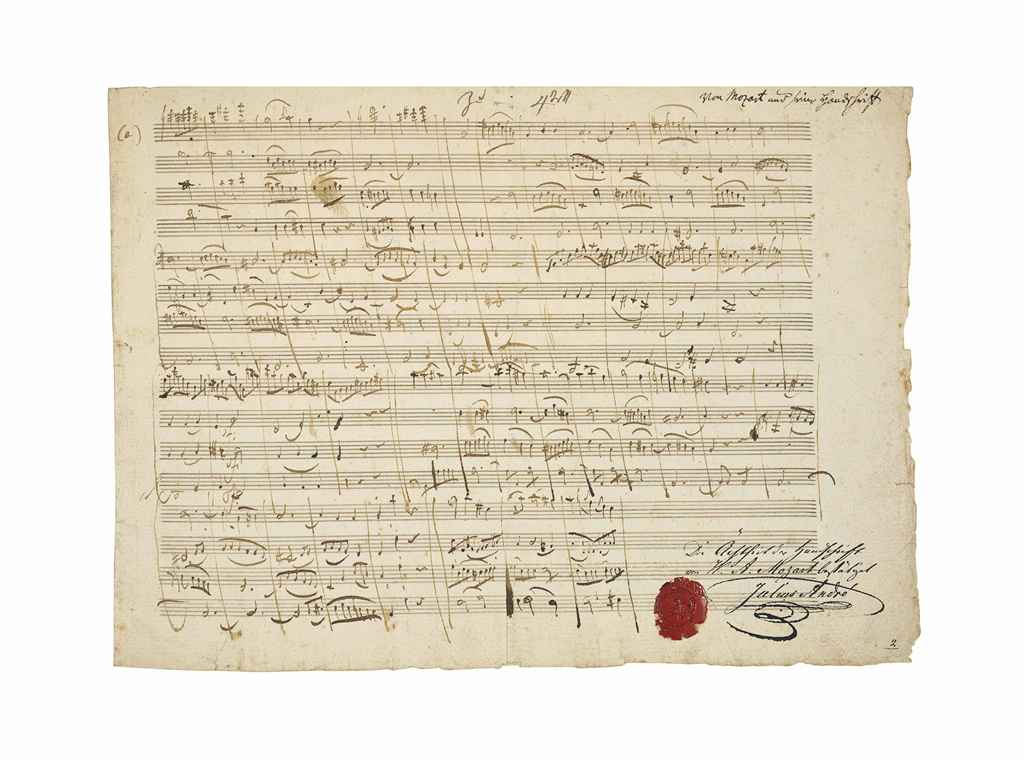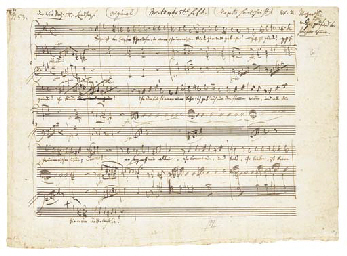MOZART, Wolfgang Amadeus (1756-1791). Autograph manuscript, working draft of an unfinished movement in G major for piano duet, K.357/500a, n.p. [Vienna], n.d. [1791], breaking off after 161 bars in 2/4 time, in brown ink on three systems of four staves per page, frequent erasures and a few emendations, annotated at the head in autograph 'Mano dritta' and 'Mano Sinistra', inscribed at the head, not in autograph, 'Sonata a 4 mains' and 'Herausgegeben ? - nicht ganz', and at the foot of p.5 'zum Andante 71te T.[?]', 6 pages, oblong folio (a bifolium and a single leaf), watermark three half moons and letters 'RGA' (occasional punctures caused by erasures), stitch marks. A FINE AND SUBSTANTIAL FRAGMENT OF A LATE WORK FOR PIANO DUET. The movement begins with a quasi-conversational opening, the eight-bar theme stated and varied by the two players in sequence; a further two variations follow in which the two parts answer each other in shorter sections; only at bar 48 do the two combine. An accompanying figure in triplets presages a ruminative passage in D major (bars 71-90), before a return to G major and an expository variant of the first theme. At bar 112 a transition occurs to C major and a passage dominated by staccato statements in the right hand against an arpeggiated triplet accompaniment in the left hand. The manuscript breaks off with an indication of a return to the original material. The correct transcription and interpretation of the annotation 'zum Andante 71te T' are uncertain (it may refer to a reprise of the D major passage), but it seems clear that the tempo of the movement is to be restrained rather than fast. The character of the piece may perhaps be described as humorous and domestic, though with brilliant declamatory passages. The transcription printed in NMA , IX:24/2, differs from the manuscript in a number of details, and lacks the last two bars. Alan Tyson's dating of the manuscript to 1791 places it alongside the great works of Mozart's frantic last period of composition - indeed it shares a paper-stock with the String Quintet, K.614, and parts of the Magic Flute and the Requiem. In view of the compositional difficulties indicated by Mozart's frequent erasures on the fifth page of the manuscript, however, it seems unnecessary to suggest that its completion was prevented by the composer's death. The form of the movement itself is clear, but the description of it as a 'Variation and Coda' and its connection with the Variations in G, K.501, in the sixth edition of Köchel are erroneous and probably stem from the misconstruction of a letter by Constanze Mozart (31 May 1800). The piece is not to be connected with the fragmentary Allegro in G K.357 (497a), written three years earlier, and no other movements have survived with which it may convincingly be associated. Published music for piano duet was rare at the time of Mozart's first surviving essay in the genre, K.19d (1765) - the influential set by J.C. Bach was not published until 1778 - and, together with J.C. Bach, Mozart did much to establish the potential of the form. The young Mozart performed piano duets with his sister Nannerl during their family concert tours - indeed the family portrait by Johann Nepomuk della Croce of 1780-1781 shows the two together at the piano - and his early compositions for the genre (K.19d, K.381 (123a) of 1772, and K.358 (186c) of 1773-4) are essentially virtuoso display pieces. By the time Mozart returned to the form in the late 1780s he brought to bear his experience of orchestral and vocal writing to exploit the quasi-conversational potential of the duet, displaying, as in the present piece, his mastery of texture and characterisation. It is clear though that the piano duet remained for Mozart a domestic form, 'essentially sociable, humorous, anti-academic' (Patrick Gale in The Mozart Compendium , 1990).
MOZART, Wolfgang Amadeus (1756-1791). Autograph manuscript, working draft of an unfinished movement in G major for piano duet, K.357/500a, n.p. [Vienna], n.d. [1791], breaking off after 161 bars in 2/4 time, in brown ink on three systems of four staves per page, frequent erasures and a few emendations, annotated at the head in autograph 'Mano dritta' and 'Mano Sinistra', inscribed at the head, not in autograph, 'Sonata a 4 mains' and 'Herausgegeben ? - nicht ganz', and at the foot of p.5 'zum Andante 71te T.[?]', 6 pages, oblong folio (a bifolium and a single leaf), watermark three half moons and letters 'RGA' (occasional punctures caused by erasures), stitch marks. A FINE AND SUBSTANTIAL FRAGMENT OF A LATE WORK FOR PIANO DUET. The movement begins with a quasi-conversational opening, the eight-bar theme stated and varied by the two players in sequence; a further two variations follow in which the two parts answer each other in shorter sections; only at bar 48 do the two combine. An accompanying figure in triplets presages a ruminative passage in D major (bars 71-90), before a return to G major and an expository variant of the first theme. At bar 112 a transition occurs to C major and a passage dominated by staccato statements in the right hand against an arpeggiated triplet accompaniment in the left hand. The manuscript breaks off with an indication of a return to the original material. The correct transcription and interpretation of the annotation 'zum Andante 71te T' are uncertain (it may refer to a reprise of the D major passage), but it seems clear that the tempo of the movement is to be restrained rather than fast. The character of the piece may perhaps be described as humorous and domestic, though with brilliant declamatory passages. The transcription printed in NMA , IX:24/2, differs from the manuscript in a number of details, and lacks the last two bars. Alan Tyson's dating of the manuscript to 1791 places it alongside the great works of Mozart's frantic last period of composition - indeed it shares a paper-stock with the String Quintet, K.614, and parts of the Magic Flute and the Requiem. In view of the compositional difficulties indicated by Mozart's frequent erasures on the fifth page of the manuscript, however, it seems unnecessary to suggest that its completion was prevented by the composer's death. The form of the movement itself is clear, but the description of it as a 'Variation and Coda' and its connection with the Variations in G, K.501, in the sixth edition of Köchel are erroneous and probably stem from the misconstruction of a letter by Constanze Mozart (31 May 1800). The piece is not to be connected with the fragmentary Allegro in G K.357 (497a), written three years earlier, and no other movements have survived with which it may convincingly be associated. Published music for piano duet was rare at the time of Mozart's first surviving essay in the genre, K.19d (1765) - the influential set by J.C. Bach was not published until 1778 - and, together with J.C. Bach, Mozart did much to establish the potential of the form. The young Mozart performed piano duets with his sister Nannerl during their family concert tours - indeed the family portrait by Johann Nepomuk della Croce of 1780-1781 shows the two together at the piano - and his early compositions for the genre (K.19d, K.381 (123a) of 1772, and K.358 (186c) of 1773-4) are essentially virtuoso display pieces. By the time Mozart returned to the form in the late 1780s he brought to bear his experience of orchestral and vocal writing to exploit the quasi-conversational potential of the duet, displaying, as in the present piece, his mastery of texture and characterisation. It is clear though that the piano duet remained for Mozart a domestic form, 'essentially sociable, humorous, anti-academic' (Patrick Gale in The Mozart Compendium , 1990).





.jpg)




.jpg)

Try LotSearch and its premium features for 7 days - without any costs!
Be notified automatically about new items in upcoming auctions.
Create an alert